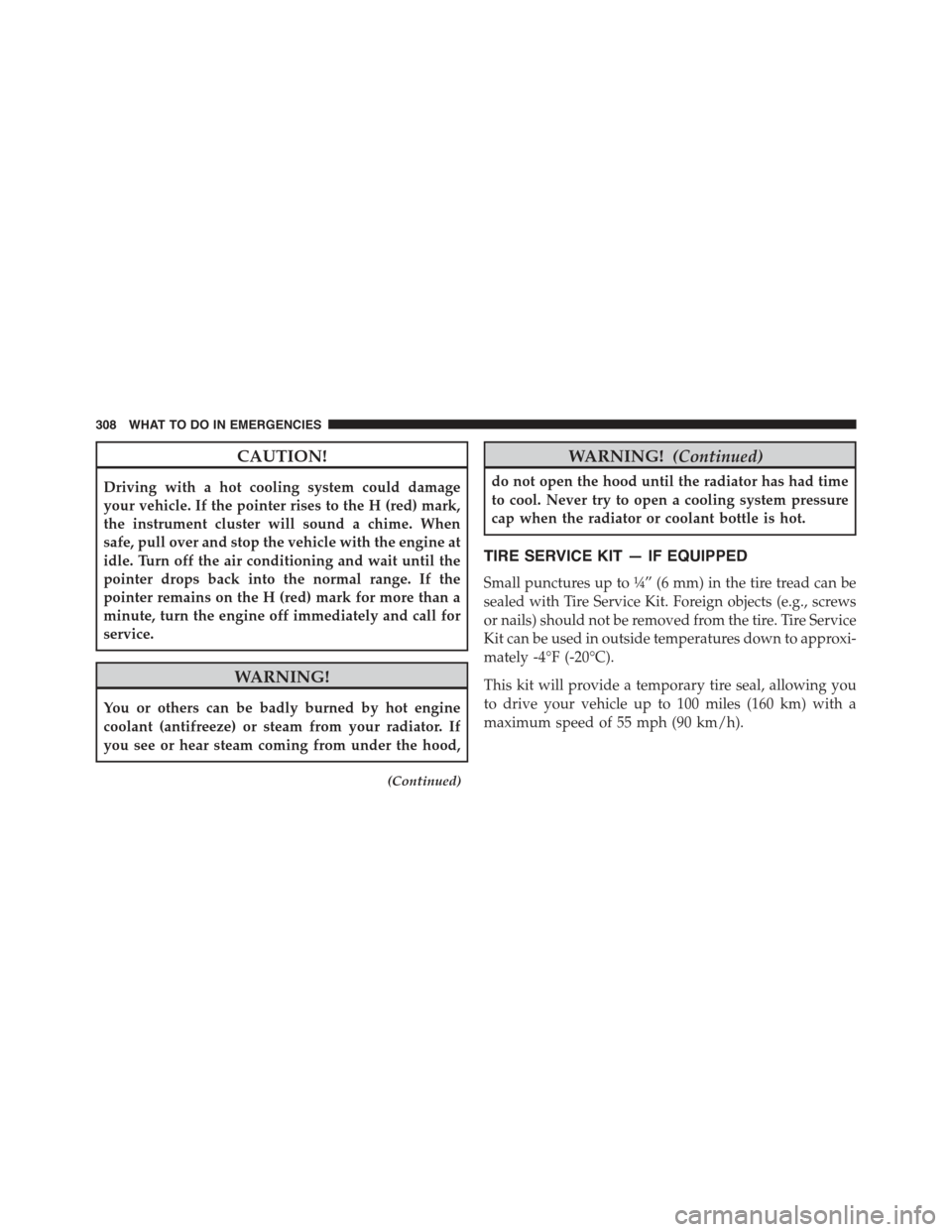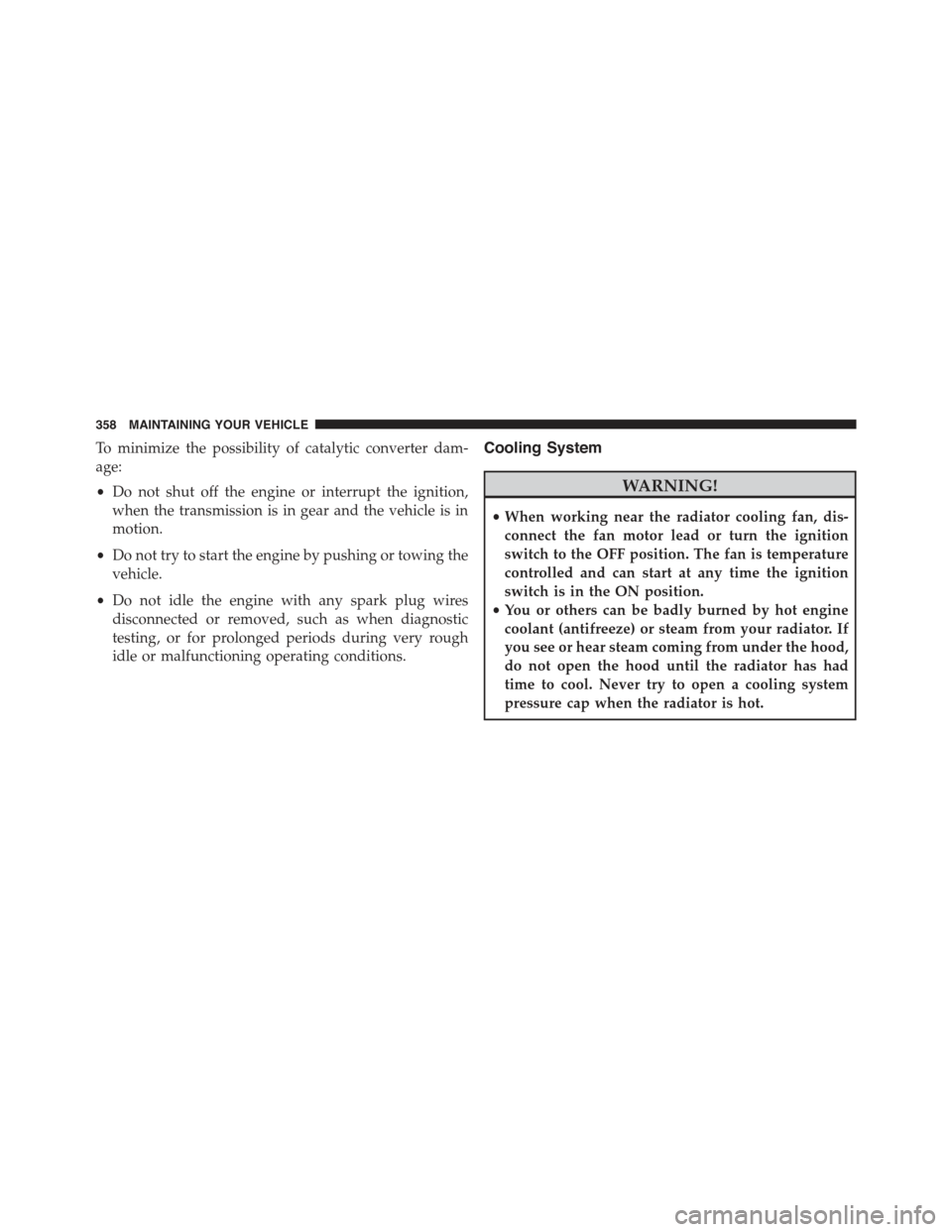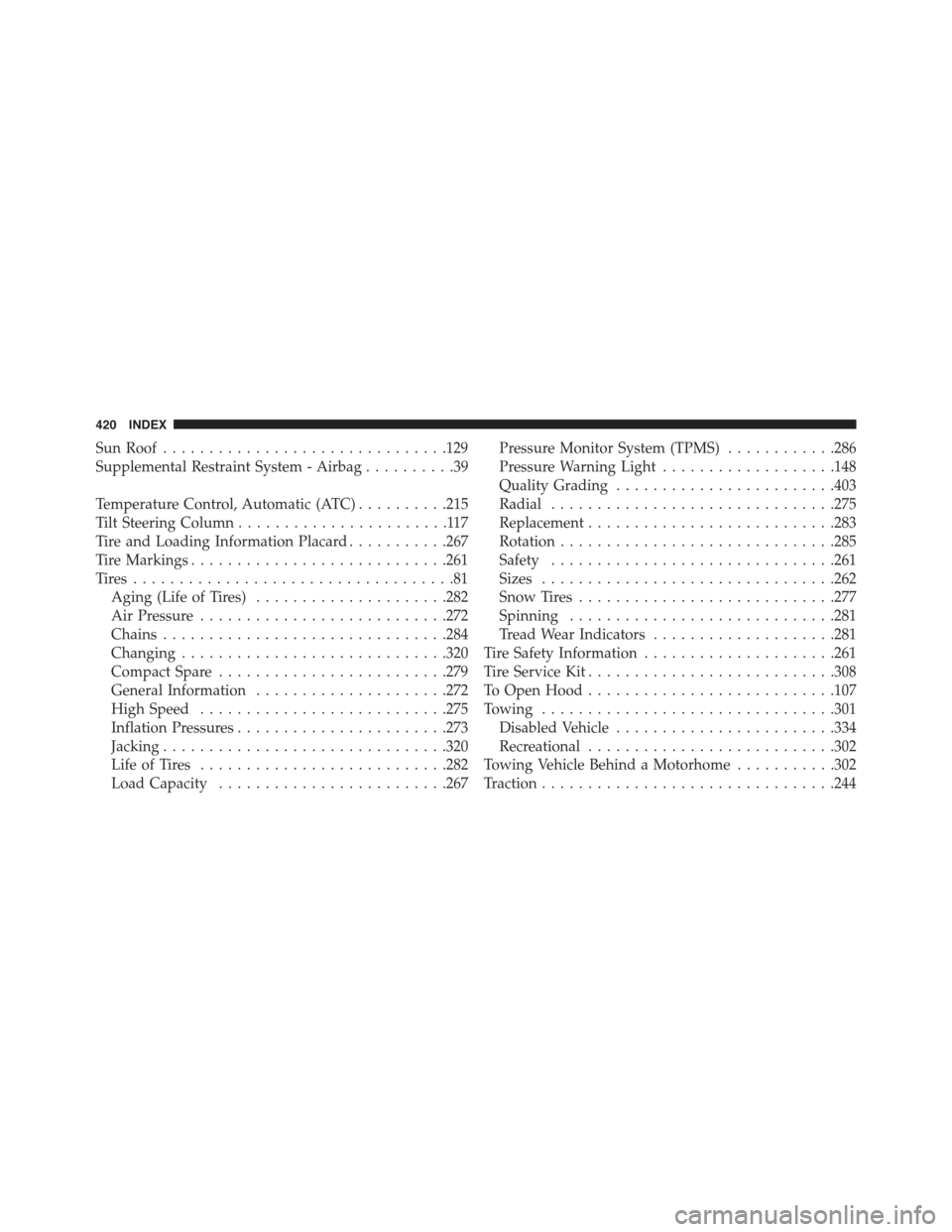Page 86 of 426

▫Seat Height Adjustment.................103
▫EZ Entry Feature......................104
▫Memory Feature......................104
▫Heated Seats — If Equipped.............105
▫Head Restraints......................106
!TO OPEN AND CLOSE THE HOOD.........107
!LIGHTS.............................109
▫Multifunction Lever....................109
▫Headlights..........................109
▫High Beams.........................110
▫Flash-To-Pass........................110
▫Parking Lights.......................110
▫Daytime Running Lights — If Equipped.....110
▫Turn Signals.........................110
▫Lane Change Assist....................111
▫Follow Me Home/Headlight Delay.........111
▫Interior Lights.......................112
▫Front Fog Lights — If Equipped...........113
!WINDSHIELD WIPERS AND WASHERS......114
▫Front Windshield Wiper Operation.........114
▫Rear Windshield Wiper.................116
!TILT STEERING COLUMN — IF EQUIPPED . . .117
!ELECTRONIC SPEED CONTROL...........118
▫To Activate..........................119
▫To Set A Desired Speed.................119
▫To Deactivate.........................119
84 UNDERSTANDING THE FEATURES OF YOUR VEHICLE
Page 109 of 426
TO OPEN AND CLOSE THE HOOD
To open the hood, two latches must be released.
1. Pull the bottom of the RED hood release lever, located
on the left kick panel, rearward.
2. Rotate the safety catch under the front edge of the
hood, near the center, and raise the hood.
Hood Release Lever
Hood Safety Latch Location
3
UNDERSTANDING THE FEATURES OF YOUR VEHICLE 107
Page 110 of 426
3. Lift the hood prop rod that clips to the right side (left
side when standing in front of the hood) of the engine
compartment. Place the hood prop rod in the hole of
hood hinge to secure the hood in the open position.
In hot climates, the prop rod may be hot. Pick up the prop
rod at the foam on the end of the prop rod.
CAUTION!
To prevent possible damage, do not slam the hood to
close it. Lower the hood until it is open approxi-
mately 6 in (15 cm), and then drop it. This should
secure both latches. Never drive your vehicle unless
the hood is fully closed, with both latches engaged.
WARNING!
Be sure the hood is fully latched before driving your
vehicle. If the hood is not fully latched, it could open
when the vehicle is in motion and block your vision.
Failure to follow this warning could result in serious
injury or death.Hood Prop Rod
108 UNDERSTANDING THE FEATURES OF YOUR VEHICLE
Page 310 of 426

CAUTION!
Driving with a hot cooling system could damage
your vehicle. If the pointer rises to the H (red) mark,
the instrument cluster will sound a chime. When
safe, pull over and stop the vehicle with the engine at
idle. Turn off the air conditioning and wait until the
pointer drops back into the normal range. If the
pointer remains on the H (red) mark for more than a
minute, turn the engine off immediately and call for
service.
WARNING!
You or others can be badly burned by hot engine
coolant (antifreeze) or steam from your radiator. If
you see or hear steam coming from under the hood,
(Continued)
WARNING!(Continued)
do not open the hood until the radiator has had time
to cool. Never try to open a cooling system pressure
cap when the radiator or coolant bottle is hot.
TIRE SERVICE KIT — IF EQUIPPED
Small punctures up to¼” (6 mm) in the tire tread can be
sealed with Tire Service Kit. Foreign objects (e.g., screws
or nails) should not be removed from the tire. Tire Service
Kit can be used in outside temperatures down to approxi-
mately -4°F (-20°C).
This kit will provide a temporary tire seal, allowing you
to drive your vehicle up to 100 miles (160 km) with a
maximum speed of 55 mph (90 km/h).
308 WHAT TO DO IN EMERGENCIES
Page 331 of 426

WARNING!
•Take care to avoid the radiator cooling fan when-
ever the hood is raised. It can start anytime the
ignition switch is ON. You can be injured by
moving fan blades.
•Remove any metal jewelry such as rings, watch
bands and bracelets that could make an inadvertent
electrical contact. You could be seriously injured.
•Batteries contain sulfuric acid that can burn your
skin or eyes and generate hydrogen gas which is
flammable and explosive. Keep open flames or
sparks away from the battery.
1. Set the parking brake, shift the transmission into gear
and turn the ignition to OFF/LOCK.
2. Turn off the heater, radio, and all unnecessary electri-
cal accessories.
3. Remove the protective cover over the positive (+)
battery post. To remove the cover pull upward on the
cover.
4. If using another vehicle to jump-start the battery, park
the vehicle within the jumper cables reach, set the
parking brake and make sure the ignition is OFF.
WARNING!
Do not allow vehicles to touch each other as this
could establish a ground connection and personal
injury could result.
6
WHAT TO DO IN EMERGENCIES 329
Page 360 of 426

To minimize the possibility of catalytic converter dam-
age:
•Do not shut off the engine or interrupt the ignition,
when the transmission is in gear and the vehicle is in
motion.
•Do not try to start the engine by pushing or towing the
vehicle.
•Do not idle the engine with any spark plug wires
disconnected or removed, such as when diagnostic
testing, or for prolonged periods during very rough
idle or malfunctioning operating conditions.
Cooling System
WARNING!
•When working near the radiator cooling fan, dis-
connect the fan motor lead or turn the ignition
switch to the OFF position. The fan is temperature
controlled and can start at any time the ignition
switch is in the ON position.
•You or others can be badly burned by hot engine
coolant (antifreeze) or steam from your radiator. If
you see or hear steam coming from under the hood,
do not open the hood until the radiator has had
time to cool. Never try to open a cooling system
pressure cap when the radiator is hot.
358 MAINTAINING YOUR VEHICLE
Page 422 of 426

Sun Roof...............................129
Supplemental Restraint System - Airbag..........39
Temperature Control, Automatic (ATC)..........215
Tilt Steering Column.......................117
Tire and Loading Information Placard...........267
Tire Markings............................261
Ti re s . . . . . . . . . . . . . . . . . . . . . . . . . . . . . . . . . . . 8 1
Aging (Life of Tires).....................282
Air Pressure...........................272
Chains...............................284
Changing.............................320
Compact Spare.........................279
General Information.....................272
High Speed...........................275
Inflation Pressures.......................273
Jacking...............................320
Life of Tires...........................282
Load Capacity.........................267
Pressure Monitor System (TPMS)............286
Pressure Warning Light...................148
Quality Grading........................403
Radial...............................275
Replacement...........................283
Rotation..............................285
Safety...............................261
Sizes................................262
Snow Tires............................277
Spinning.............................281
Tread Wear Indicators....................281
Tire Safety Information.....................261
Tire Service Kit...........................308
To Open Hood...........................107
Towing................................301
Disabled Vehicle........................334
Recreational...........................302
Towing Vehicle Behind a Motorhome...........302
Traction................................244
420 INDEX